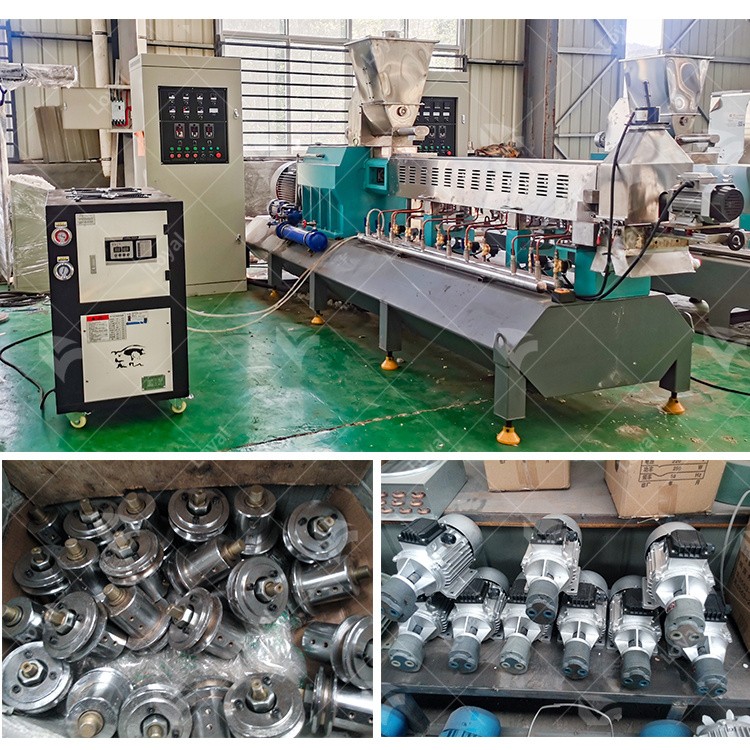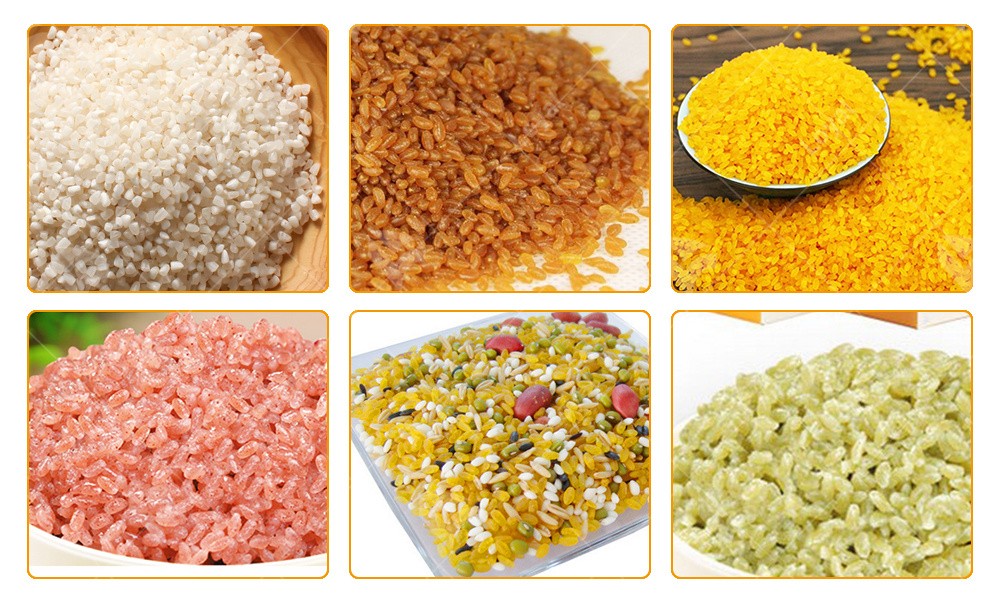
- Shandong Loyal Industrial Co.,Ltd.
- Macaroni Production Machine Instant Noodle Machine Biscuit Making Machine
Home> Company News> Artificial Rice Production Line Introduction

Artificial Rice Production Line Introduction
2023-05-22 12:11:29An artificial rice production line is a machine-based system for the production of synthetic or imitation rice made from different raw materials. It is a cost-effective solution to feed people in areas with unstable rice supplies or in countries where rice is in high demand but cannot be produced locally. The production line consists of multiple machines that process, extrude, shape, and dry raw materials into artificial rice grains. The process involves mixing raw materials such as potato starch, corn flour and rice flour with water to form the dough. The dough is then extruded through a molding machine to form rice grain-like shapes. Finally, the rice grains are dried in a dryer, sterilized, and then packaged for sale or distribution. Artificial rice has a longer shelf life than natural rice and is easier to store and transport, making it an attractive option for emergency food aid or disaster relief efforts. It is also an option for people who want to reduce their carbohydrate intake or have certain health conditions that limit rice consumption. In summary, artificial rice production lines offer a viable solution to address food insecurity and are becoming an increasingly popular option in the food industry.

Artificial Rice Process Line Flow Chart
- Raw Material --- 2. Crushing-Ingredients --- 3. Mixing --- 4. Extrusion --- 5. Pre-Drying --- 6. Drying --- 7. Cooling --- 8. Packaging

Artificial Rice Process Line Parameter
|
Model |
Capacity (kg/h) |
Insta11ed Capacity (kw) |
Actual Consumption(kw) |
Speed Control Mode |
Dimension(m) |
|
LY3000 |
80-100kg/h |
55. 35kw |
41.51kw |
Inverter |
24*4*3m |
|
LY70L-I |
150kg/h |
63. 54kw |
47. 66 Kw |
Inverter |
24*4*3m |
|
LY70L—Ⅱ |
300kg/h |
103kw |
77. 25 Kw |
Inverter |
24*6*3m |
|
LY70L—Ⅲ |
450kg/h |
172. 64kw |
129.48 Kw |
Inverter |
2. 7*0. 9*3m |
|
LY70L—Ⅳ |
500kg/h |
215. 16kw |
161.37 Kw |
Inverter |
20*12*3m |
|
LY70L—V |
600kg/h |
268kw |
201 kw |
Inverter |
20*12*3m |
|
LY80-I |
300kg/h |
101.6kw |
76. 2 kw |
Inverter |
35*4*3m |
|
LY80-Ⅱ |
600kg/h |
98kw |
73. 5 kw |
Inverter |
35*7*3m |
|
LY80-Ⅲ |
900kg/h |
356kw |
267 kw |
Inverter |
35*12*3m |
|
LY75 |
500kg/h |
132kw |
99 kw |
Inverter |
50*4*6m |
|
LY95 |
700kg/h |
205kw |
153. 75 kw |
Inverter |
59*8*6m |

The Function Of Artificial Rice Production Line
An artificial rice production line is a machine-based system for the production of synthetic or imitation rice made from different raw materials. It is a cost-effective solution to feed people in areas with unstable rice supplies or in countries where rice is in high demand but cannot be produced locally.
The production line consists of multiple machines that process, extrude, shape, and dry raw materials into artificial rice grains. The process involves mixing raw materials such as potato starch, corn flour and rice flour with water to form the dough. The dough is then extruded through a molding machine to form rice grain-like shapes. Finally, the rice grains are dried in a dryer, sterilized, and then packaged for sale or distribution.
Artificial rice has a longer shelf life than natural rice and is easier to store and transport, making it an attractive option for emergency food aid or disaster relief efforts. It is also an option for people who want to reduce their carbohydrate intake or have certain health conditions that limit rice consumption.
In summary, artificial rice production lines offer a viable solution to address food insecurity and are becoming an increasingly popular option in the food industry.

The Advantages Of The Artificial Rice
|
Improved Nutritional Value |
Artificial rice can help address nutritional deficiencies in populations that rely heavily on rice as a staple food. By adding nutrients to rice, it can provide a more balanced diet and improve overall health. |
|
Increased Shelf Life |
Fortified rice has a longer shelf life compared to regular rice, which makes it a more practical and cost-effective option for food aid programs. |
|
Cost-Effective |
Artificial rice is often more affordable than other food sources of similar nutritional value, making it an attractive option for people with limited resources. |
|
Easy to Prepare |
Artificial rice can be cooked in the same way as regular rice, making it easy to prepare and incorporate into meals. |
|
Versatile |
Fortified rice can be used in a wide range of dishes and cuisines, making it a versatile food option. |
Overall, artificial rice can help improve the nutritional status of populations that rely heavily on rice as a staple food, providing a cost-effective and practical solution to address malnutrition and food insecurity.

The Advantages Of The Artificial Rice Process Line
Rice fortification is a production process that adds essential micronutrients to unpolished or polished rice grains, thereby enhancing their nutritional value. Here are some possible advantages of fortifying rice production lines:
1.Improves The Nutritional Content Of Rice: Fortified rice contains additional trace elements such as iron, zinc, vitamin A and vitamin B, which are essential for good health.
2.Reduce The Risk Of Malnutrition: Fortified rice can help address malnutrition in undernourished communities, especially in developing countries where rice is a staple food and other sources of nutrition are limited.
3.Improved food security: Fortified rice provides a stable food source and helps improve food security in vulnerable communities.
4.Cost-Effective Solution: Fortified rice production lines are cost-effective compared to other methods of fortifying food, making it a viable method of supplying essential micronutrients to large populations.
5.Ease Of Implementation: Fortified rice production lines are simple and easy to implement, and producers large and small can adopt this method to enhance the nutritional content of their rice products.
Overall, intensification of the rice production process can help address nutrient deficiencies and food insecurity while providing cost-effective and easy-to-implement solutions.

 Commercial Japanese Panko Bread Crumb Grinder Machine
Commercial Japanese Panko Bread Crumb Grinder Machine Japanese Bread Crumbs Processing Line
Japanese Bread Crumbs Processing Line Automatic Cookies Making Machines
Automatic Cookies Making Machines Fully Automatic Biscuit Making Machines
Fully Automatic Biscuit Making Machines